|
This web site is concerning a macroscopic approach (mushroom recognition by field attributes). Microscopists will have their own resources for a next step.
Stomach fungi is a functional container concept, based on systematical form comparison (morphology).
Our perception of the fungi world might be different from the way the world is organised genetically.
Form description and comparison are the basics of learning fungi. Form metapfore, colors, smell, taste, pinch is where it all starts: using all sense-organs for perception.
When we are experiencing nature, we don't care about genetics. We want to share our astonishment of senses and the richdom of forms.
Naming the world around us, deploring relationships of habitats and species are incentives to share it's value.
We just need a few simple steps to organise our knowledge in an effective way.
|
Stomach fungi (Gasteromycetes) in the Amsterdam Area |
The Actors
Stomach fungi is a group of mushrooms forming caveties around their spores. The spores are released in the cavety as the fruit-body gradually matures. From there the spores can escape through pores in the inner wall from the fruit-body.
In literature since the seventies it is stated that this group is an artificial, not natural existing taxonomic ordering. Research evidence implicates fungi in this group inherit too many genetic properties of agarics (agaricus, lepiota, and boletales).
Anyway, spores in stomach fungi are growing on reproductive cells (basidiomycetes).
Stomach fungi is not a uniform group of inner and outer forms. What they do share is a fertile tissue (gleba), and often an infertile, supporting tissue (subgleba). There might be holes in the supporting tissue,
and those holes can be organised single chambered (stiff) or multi chambered (spongy). They might have some kind of inner stem (pseudocolumella).
They have a upper skin (exoperidium) and may have a lower skin (endoperidium). The upper skin may have scales, spines, warts, ridges, fibres, pruina, and so on.
The lower skin may have one or more openings for releasing the spores (pores), and might have very thinly perforations of lost spines or might have warts as
remaining parts of the worn outer skin. Earthstars might have cristal pruina or warts on their endoperidium.
Lots of terms (concepts), and adjectives are needed for an adequate description.
And metaphors. Many stomach fungi do have a more or less rounded shape. How to name it?
The teacher Math always said "never compare apples with pears!"
In mathematics that is correct, but talking about spherical, globose or ovoid fungi it is a must.
Learning fungi is language learning, too.
|
|
The Stage
Amongst the stomach fungi group a lot of species prefer poor sandy soil (dunes) under rather rough and extreme conditions (in permanent pioneer vegetations).
The original soil of Amsterdam is peat and clay. Soil and vegetation near the city is much more fertile. To find dune species, someone has to go to the Northsea dune coast or
to look for city developmental areas, where sea sand is used to raise dikes, (rail-)roads, railway yards, harbours and recreative parks.
Southeast of Amsterdam there is an area, Het Gooi, positioned on a preglacial pleistocene sandhill relict.
Over there is non calcareous, poor sand, partially with woodland (summeroak-birch) and heathland.
To find dune species there, you have to go to the borders of the hills, on raised recreation beaches, at the foot of bridges (Hollandse bridge A6, Stichtse bridge A27), on dike bodies of relatively new highways (A27), and to the remaining dune and cliff coast of the former Zuiderzee.
Those are places with calcareous sandy soil.
Generally speaking, it is the origin of the sand being used for dikes, railway lines, and other city development, which determinates the chance to find certain species.
That sand upto 1960 came from Het Gooi (non calcareous), in the years round 1970 it came from from the Zuiderzee area (calcareous), and from the Gaasperplas (less calcareous), round 1980 from the North Sea (calcareous),
and the last years from the fairway Amsterdam-Lelystad (partial calcareous). You just have to know where they used it for.
Within a few years on (won under water) seasand mushrooms are growing. That is an interesting observaton found in the book Champignons in de Jordaan (1999).
This book forms the result of a five years long research of mushroom distribution in and around the city of Amsterdam.
|
Spores of stomach fungi are water-repellent.
Even during heavy rains the spores disperse easily. Ask a child to pinch gently in a ripe earthstar or puffball, and see the
exaltation in his eyes (and his parents)
while a dark brown cloud of spore mass is rizing, contrary to the expectation, against the steady rain fall.
| |
Spores of most other types of mushrooms are attached to each other in the rain.
Those (gilled) mushrooms are protecting their spores with an umbrella against water. This is why you must reset a picked mushroom afterwards.
Because than it still has a chance to release the spores later.
|
 |
|
 |
Earthstar and look alikes are stomach mushrooms.
There is some kind of tulip bulb in the ground. It splits open in a number of slips.
The slips reveal a little ball. Slips are while curling outwards (and often downwards) pushing up that little ball. The miracle is a fact. A new star is born.
Earthstars and look alikes are divided into Barometer Earthstar (Astraeus), Leather stars (Mycenastrum), and Pepper Pots (Myriostoma).
Geastrum species do have one single, infertile kind of stem (columella), and will get only one pore for releasing the spores.
Species with none or with more than one, do not belong to genus Geastrum.
Barometer Earthstar (Astraeus hygrometricus) and Leatherstar (Mycenastrum corium) have none, Pepper Pot (Myriostoma coliforme) has many of them.
Counting the number of pores seems to be more efficient, but is not always practical. Young earthstars still have to grow.
A lot of their attributes are developing during maturation. Only a few features are there from the very beginning: scars, encrusted debris, some mouth-opening parts.
See:
a Macroscopic Key to Earthstars (based on scars).
| |
Puffballs are stomach mushrooms. Puffballs often have a pear shape (so called ´pyriform´). Part of the pear shape has a stem function.
In that stem-like part of the pear-shape puffballs do have special tissue to remain erect. It is supporting tissue, with holes in it for strength and elasticity.
Puffballs may have all sorts of typical field attributes: with or without stem, with or without spongy tissue in the stem foot,
with or without so called 'roots ' (rhizomorphs), with or without pores (rounded openings at the top for pooring out the spores).
This group of species may be divided into
true puffballs, (like Lycoperdon, Calvatia or Handkea, Vascellum genus),
bovists (like Bovista, Langermannia genus),
stalkballs (Tulostoma genus), and
earthballs (Scleroderma genus).
This division again is a bit arbitrary. In some countries they don't split them at all. A reason for splitting them is field recognition.
Real puffballs do have a spongy subgleba, Bovists don't, they are stiff if they have subgleba, and some Bovists do not have subgleba at all.
Just feel it, and you know the difference.
Stalkballs have a stalk or stem under there globose form,
and often this stem is complete underground.
Earthballs are different from all the others with their thick leatherish skin.
|
 |
| 
|
Stinkhorns are stomach fungi.
They are easily recognized by its shape and evil smell.
They start being eggs in the ground. Even under ground they smell already.
Almost all stinkhorns are bound to the presence of certain types of wood,
either to moulded wood, either to leaf litter.
Better not to pinch in there, because it smells, and you can't help spreading the spores.
| |
Birds nest fungi are stomach fungi.
The spores are formed in an "egg" (peridiole).
Each egg sitting at a small bird's nest, can fly away up to a 5 feet distance.
|
There are more groups of stomach fungi, like Truffels and False Truffels. You cannot find them on this web site,
due to some self made restrictions. Maybe later.
|
Puffball Equipment:
For puffballs you need a loupe (10x), a knife (for fresh meat ones), a household scissors (for older, greyer and clayer ones),
a little ladle (to dig in the ground to find out if there are any rhizomorphs), and KOH (for earthballs).
It is important to watch: scales, spines or warts on the skin.
It is important to find out if the skin you see is the outer or the inner skin (outer skin can be worn, already)
It is important with pear shaped forms to feel if the supporting tissue (subgleba) is stiff or spongy.
It is important to test if the skin is thick or thin.
It is important to make a cross-section (to determine if subgleba is separated from gleba, and to photograph the holes in it).
It is important to dig out stomach fungi to inspect the rhizomorfs by which fruit bodies might be attached to the ground.
In addition, it is better to inspect as well younger as well older stages.
In order to study stomach mushrooms you should be prepared to demolish to quite a bit.
I think this is a disadvantage because many species are pretty rare, especially in this region around Amsterdam.
|
Fotographer tips:
To shoot or not to shoot, that's the question.
If you do it, do it as complete as possible.
Pictures of puffballs are very hard to understand later.
Do it as complete as possible. Always top plus bottom. And some extra's for certain groups:
- Earthstar: visibility of mouth-zone, stem, collar (under the ball), cylinder, slips, scar, encrusted debris.
- Puffballs: check for pseudo roots (rhizomorphs), rub out some spines or scales to check the effect.
- Earthballs: take care of wall thickness, and color changings, rub out some warts, use a drop of KOH.
|
![weerhuisje (Astraeus hygrometricus [Pers.] Morgan)](../paddenstoelen/basidiomycetes/ga_key/astraeus.hygrometicus1.jpg)
Barometer Earthstar (Astraeus) |
![Lederster (Mycenastrum corium [Guers. ex DC. & Lam.] Desv. ()](../paddenstoelen/basidiomycetes/ga_key/mycenastrum.corium1.jpg)
Leatherstar (Mycenastrum) |
![Peperbus (Myriostoma coliforme [With.: Pers.] Corda)](../paddenstoelen/basidiomycetes/ga_key/myriostoma.coliforme1.jpg)
Pepper Pot (Myriostoma) |
Earthstar and look alikes (Astraeus, Geastrum, Mycenastrum, Myriostoma) |
Earthstar species of genus Geastrum do have one and only one infertile stem
(columella). Species without, and species with more than one don't belong to the genus Earthstar (Geastrum).
Barometer Earthstar (Astraeus hygrometricus) and Leatherstar (Mycenastrum corium)
have none; Peper Pot(Myriostoma coliforme) has many.
See:
Macroscopic Key to earthstars and look alikes, and the Anatomy of Geastrum species.
|
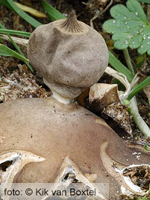
|
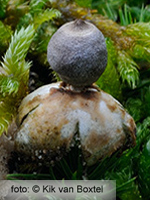
|
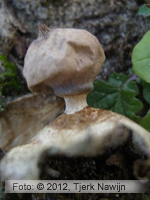
|
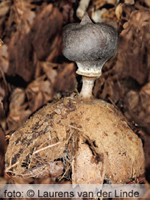
|
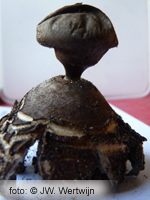
|
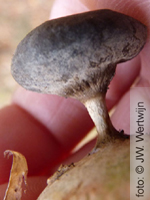
|
Field Earthstar |
Tiny Earthstar |
Dwarf Earthstar |
Striate Earthstar |
Crowned Earthstar |
Beaked Earthstar |
Earthstars with a visible "stem":
|
|
Earthstars without a visible "stem"
|
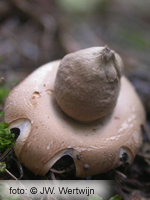
Elegant Earthstar |

Sessile Earthstar |
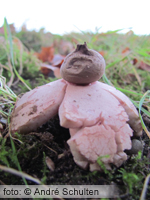
Rosy Earthstar |
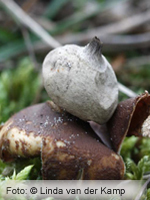
Felty Earthstar |
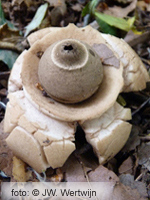
Collared Earthstar |
 |
|

|
Real Puffballs
(Calvatia, Lycoperdon, Vascellum ) |
|
Real Bovists
(Bovista, Langermannia ) |
Puffballs are pear-shaped. They all have a stem shaped area in the pear. Young they have white undifferentiated meat. On maturation subgleba is formed in the stem part of the pear.
Subgleba is always multi chambered, and feels like a good sponge.
Many pear-shaped species start with spines all around. Some species are loosing their spines very fast.
You can wipe off or scratching off spines. You do that to see if it causes a mesh-like structure or not, and to see if it causes
a color change of the skin.
If the spores are ripe a hole on top (apex) is created.
The spores are drifting away on the wind; the pear-shape with the sponge structure remains standing there.
Puffballs life on the ground (rarely on moulded wood) and break off litter.
- See:
Macroscopic Key to Real Puffballs.
|
|
Bovists are prune-shaped to pear-shaped.
Young bovisten have white undifferentiated meat. On maturation the meat changes into brownish gleba.
Most bovist species do not have subgleba, and if they have, it is never multi chambered
Bovists never have spines. The surface is at most branny, floury, grainy or warty.
If the spores are matured, the top rips open, and the wind takes it all, including the whole bovist body.
Bovisten life on the ground and breaking litter.
- See:
Macroscopic Key to Bovists.
|
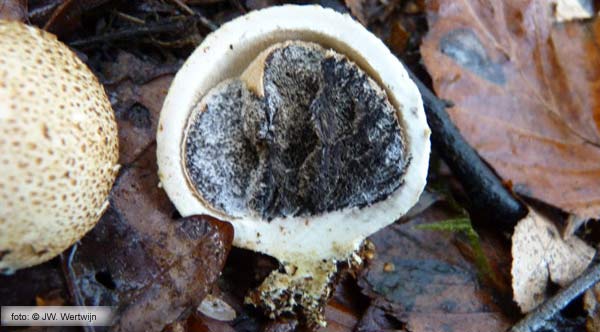
Common earthball
|
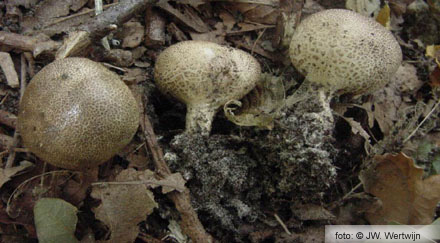
Scaly earthball
|
Earthballs are compact and heavier than puffballs.
They have a rather thick, leatherish skin, around a massive body.
That is much thicker and firmer than puffballs. Young they have hard, more or less white meat inside.
While maturing the white meat changes into a dark spore mass. If the spores are ripe, the outside wall rips open
in quite irregular forms, usually at the top (apex).
Earthball generally are firmly attached to the ground (rhizomorphs), and some species do have a pseudo-stem
(also rhizomorphs). Normally they grow on the ground, rarely on wood.
All types of Scleroderma grow in mixed deciduous and coniferous forests,
on nutrient-rich land; sandy, loam, clay and peat-land.
They are supposed to form a symbiotic relationship with tree roots.
Most species are autumn species (August till October).
|
|
Most species have an outside wall with a scaly structure.
The kind of scales, and the scales position are the most important attributes to distinguish species from eath other.
For example, Potato earthball's only have scales near the apex, not at the lower parts of the fruit body.
That is why they are called baldy. All other species do have scales at the sites and even lower. Even the Leeky earthball, though sparsely only.
While maturing the upperskin can get cracks, and the colors in that cracks help you to find out which of these species is the one.
Scales, skin color, pattern, root length, color change and odor
when crabs or cutting, are the main attributes for a
Macroscopic Key to earthballs.
|
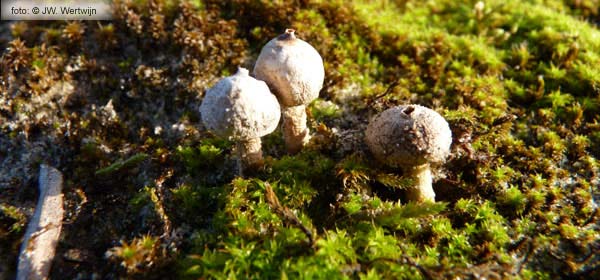
|
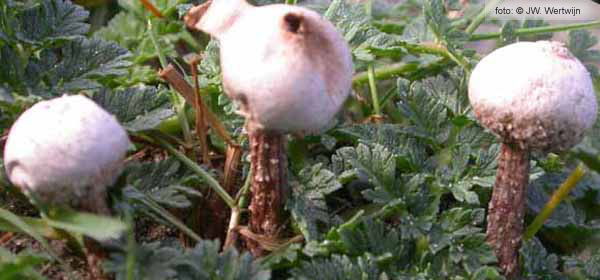
|
Stalkballs consist of a globose shape on a long stem or stalk (called stipe).
The stipe is formed underground, and is gradually becoming visible when wind and rain are pushing away the surrounding sand.
In the globose shape spores are formed. At maturation a hole in the top of the ball is created, and spores are poored out.
Stalkballs are lime lovers, and that means you need to find them in calcareous land,
open grassland, sandy places, with alges and mosses.
They are rare in the Nederlands, but when there are somewhere, they are there gathered together with thousands of them.
Basically, there are three different species. You do not need a macroscopic key for that.
If the pore on the apex has no chimney form, it is a
Sessile stalkball (Tulostoma fimbriatum), else if there is a chimney and the stalk is dark,
it is a Scaly stalkball (Tulostoma melanocyclum),
else if stipe is a bit white till pale brown then you have found a Winter stalkball (Tulostoma brumale).
|
|
Stalkballs are found in de Amsterdam region since 1998. Especially in the westport area of Amsterdam.
The Amsterdam westport area was stripped off in 1997 (stripped of top layer plus vegetation).
This changed the area into a typical dune habitat (a pioneer vegetation).
The westport area remains promising. It contains a thick suit Northsea sand (very calcareous) on the original marine clay layers.
Elsewhere, sandy soil is becoming enriched in only a few years by tree leaves. That makes the habitat changing fast into some ruderal area with more and more trees and bushes.
Part of the success of the westport area are the rough weather conditions of open areas where the wind can blow and, like in the dunal coast, vegetation is
permanently set back to a pioneer environment. Stalkballs love that kind of conditions.
Promising new areas with calcareous sand (from the fairway Amsterdam-Lelystad) are: Diemerzeedijk (or Diemer park), and the new islands of IJburg
(one of the newest parts of Amsterdam) built on the former Zuiderzee bottom.
|
White Stalkball (Tulostoma niveum Kers 1978) is not found in the Netherlands.
It seems to be a nordic type, related to (but macroscopic different from) T. Brumale, to be found in Sweden and Schotland.
Its Habitat is in moss tussocks (bryophilous), on bare limestone rocks (calcareous soil), in treeless areas
(source: http://www.mycobank.org number MB325133).
In the Netherlands there are some variants: Tulostoma brumale var. brumale, var heterosporum and var. pallidum,
and Tulostoma fimbriatum var. fimbriatum and var. heterosporum. As far as I know, these are microscopical variants only,
so beyond the scope of this website.
|
Stinkhorns (Clathrus, Mutinus, Phallus) |
Stinkhorns are easily recognized by its shape and evil smell.
They start being eggs in the ground. Even under ground they already smell awfull.
An egg is a white, silky egg-like structure full of jelly, in which is embedded a conical cap.
The cap is only attached at its top to a futural cylindrical white, spongy, hollow stem.
Everything is already there, in the egg, it's still waiting to escape and eject.
The jelly in the egg is a water store, and is used to expand rapidly.
If you cut through the egg of (the common) Stinkhorn, you see how, and it's delicious if you can decide to eat it.
In a guided tour this can only be successfull if you are willing to eat it in front of the public.
|
|
There are two ways for stinkhorn distribution: the most simple one is by mycelium in the ground.
It is running from one place to another. The most complex way this egg is developed for.
As soon the egg is opening, the stem elongates, carrying the cap and spore-mass with it.
It's attractive to flies, and they feed upon it.
They transport spore, sticked to their feet, from one place to the other.
|
Excluded Stinkhorns:
There are more Stinkhorn species in the Netherlands than currently available at this website, including
Red Cage (Clatrus ruber) (NMV Ga 205010),
Elegant Stinkhorn (Mutinus elegans) (NMV Ga 219030),
Veiled Lady (Phallus duplicatus) (NMV Ga 208010).
Sand Stinkhorn (Phallus Hadriani) (NMV Ga 225010),
The list-numbers (NMV GA 00.00.00) can be used to refer to the Dutch Mycology Distribution Atlas (not in English).
And exactly this is the way it is used on this website's species info pages. Each SIP (Species Info Page) refers to the MAP (Mycology Atlas Project).
|
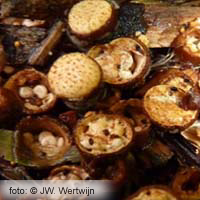
Common Bird's Nest |
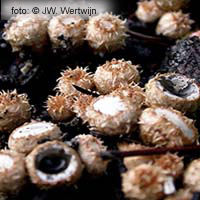
Field Bird's Nest |
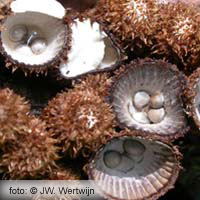
Fluted Bird's Nest |
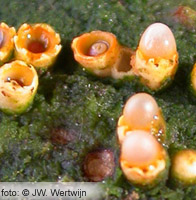
Shooting Star |
Bird's Nest fungi
(Crucibulum, Cyathus, Nidularia, Sphaerobolus )
|
The most endearing for your public, are eggs in nests. Crazy how nature knows how to surprise with reinventing the flywheel,
but then again just using it slightly different. A guided tour is more successfull with such elements in it than without.
|
|